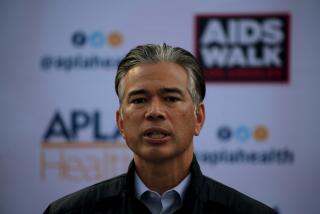The Prognosis for Health Stocks Is Disappointing
- Share via
The list of sellers of medical stocks keeps getting longer, even as the stocks get cheaper. The newest members to join the lineup: The health care stock mutual funds, whose small-investor shareholders sat patiently through the dismal performance of 1992, but who now appear to have reached their limit of pain.
The $550-million Financial-Invesco Health Sciences fund in Denver, for example, has already suffered $100 million in redemptions so far this year. That redemption rate now matches the total that investors sold out of the fund all last year.
Likewise, the $480-million Vanguard Special Health fund in Boston has seen $61 million flow out so far this year, after taking in a net $70 million in new money last year despite health stocks’ woes.
The temptation is to believe that if the small investor finally is giving up on health care, this must be the bottom. After all, the stocks have been falling for a year. While President Clinton’s latest attacks on the industry have been vicious, they weren’t unexpected. By this point, you’d think the stocks would reflect all the bad news and more.
That’s the bullish case, anyway. But there’s good reason to disbelieve it. Medical stocks, especially drug shares, can and probably will go lower by spring, some pros say. And after that, many of the stocks may be dead money for a long time.
From Wall Street’s standpoint, the trouble here isn’t just that the President believes medical company profits are too high. A bigger problem is that too many investors have looked upon health care stocks as a “sure thing” for too long.
The stocks are, in technical parlance, over-owned : They’re already in so many investors’ portfolios that, when trouble hits, you’re virtually guaranteed to have an excess of sellers trying to dump the shares on a much smaller universe of buyers. So prices keep going down.
The accompanying chart shows the 13 most-owned stocks on Wall Street as of last Sept. 30. Most-owned here is based on the number of big institutional investors holding the shares. Philip Morris Cos., for example, takes top honors because 789 institutions reported owning that stock. The data comes from routine quarterly filings that money managers make to federal regulators.
Of the 13 most-owned issues, five are drug stocks, including bellwethers Merck, Bristol-Myers and Abbott Labs. Because the drug industry’s earnings consistently grew at high double-digit annual rates from the mid-1980s through 1991, big investors came to believe that major drug firms were must-own stocks. So the institutions--and many small investors--loaded up on these shares at a phenomenal pace in the ‘80s.
Now, no one is quite sure what the companies’ earnings growth will look like in the ‘90s. Most analysts still believe that the best drug firms are capable of 10% to 15% annual earnings growth. But there suddenly are many uncertainties going forward, and federally mandated health care cost-containment is only one of them.
There is, for example, the issue of upcoming patent expirations on key drugs. Edward Owens, manager of the Vanguard Special Health fund, notes that there were few patent expirations between 1988 and 1991. But over the next few years, big drug companies will face the loss of patent protection on a host of major drugs. That will bring generic competition, slashing prices.
Nearer term, there are fears that the drug firms will actually engineer their earnings to be disappointing this year, in the hope of deflecting criticism of their fat profit margins. Sound ridiculous? Hardly, says Richard Walton, investment strategist at Wertheim Schroder & Co. in New York. “The last thing I’d do if I was a drug company is show good earnings now,” he says. That would be like waving a red flag at Mr. and Mrs. Clinton.
It’s also true, of course, that the major drug stocks have already fallen to levels that suggest they’re dirt-cheap, even with much slower earnings growth. Merck, for example, is at $38.375 a share now, down 32% from a peak of $56.625 last year. The stock’s price-to-earnings ratio is a mere 15, based on expected 1993 earnings per share.
Isn’t that a compelling value? “As corporations, the drug stocks now may be attractive,” Walton admits. But he returns to the over-ownership issue: “There’s just no way of knowing how much more money wants to come out of these stocks.”
Equally important, there doesn’t appear to be any sense of urgency on the part of potentially interested buyers. John Kaweske, manager of the Financial-Invesco Health fund, admits that even if he had the cash, drug stocks wouldn’t top his buy list--even though he believes the shares may already discount some sort of federal price controls. He’d rather buy health-maintenance organization stocks and other faster growers.
For the drugs, one possibility for nadir will come in mid- to late-March, if more big portfolio managers decide they don’t want to show drug stocks on their first-quarter statements to clients. That could spark a rush of selling before March 31.
Beyond that, the only people who belong in these stocks are the truly long-term investors, says Nick Whitridge, manager of the Babson Value Fund in Boston: “It’s going to take a patient value investor to make money here.”
The Most-Owned Stocks
Drug stocks have fallen sharply in part because so many institutions built up huge positions in the stocks in the ‘80s. As they begin selling, the pressure is enormous.
Institutional holdings Number of Stock (in billions) institutions Philip Morris $43.99 789 General Electric 34.69 765 Bristol-Myers 16.88 739 Merck 26.35 737 Exxon 30.56 732 IBM 20.19 717 AT&T; 19.24 701 Johnson & Johnson 17.55 697 Pepsico 16.45 669 American Home Products 12.57 658 Coca-Cola 27.55 644 GTE Corp. 15.28 628 Abbott Labs 11.62 625
Data as of Sept. 30, 1992
Source: CDA Investment Technologies
More to Read
Inside the business of entertainment
The Wide Shot brings you news, analysis and insights on everything from streaming wars to production — and what it all means for the future.
You may occasionally receive promotional content from the Los Angeles Times.









